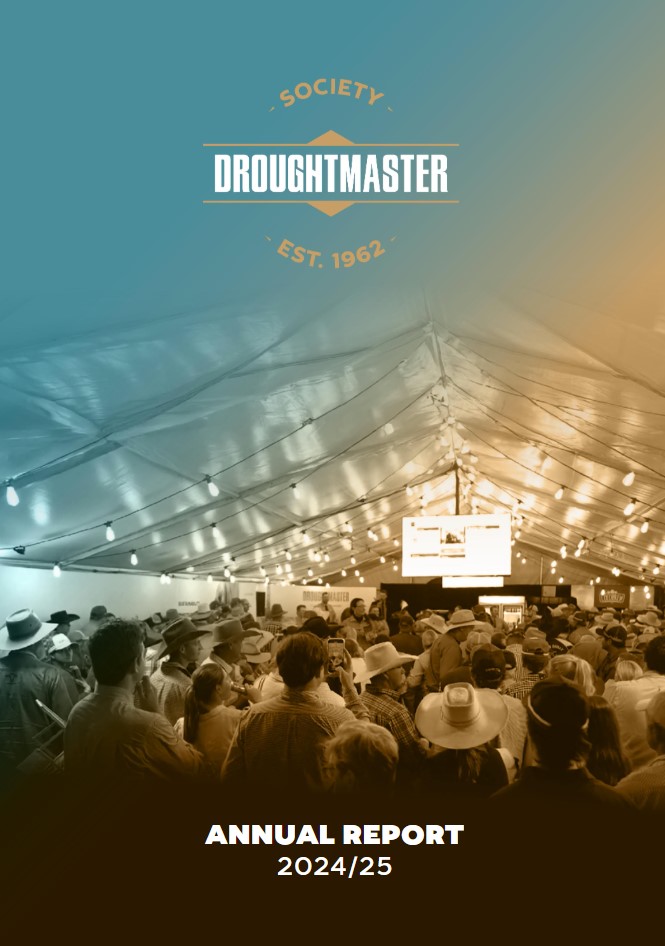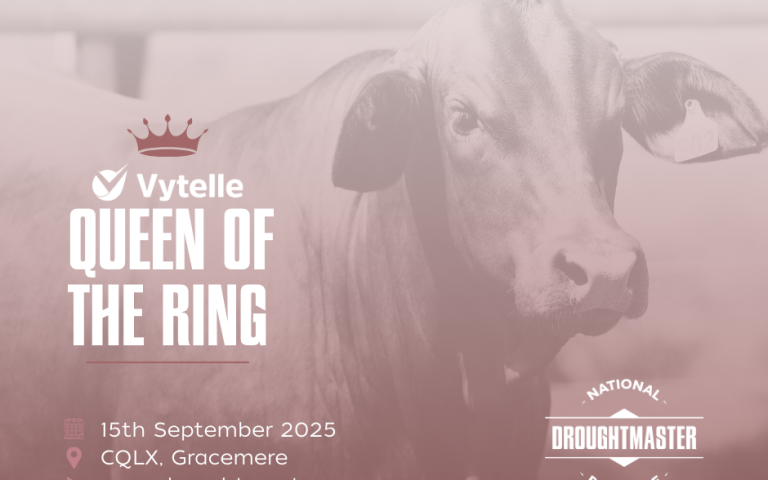Vale Bruce Campbell AM MBE
1 Apr 2022November 2021
It is with great sadness we inform the membership of the passing of Droughtmaster Stud Breeders’ Society Life Member and ex President Bruce Campbell.Born in Longreach, Mr Campbell‘s working career was devoted to the rural industry. Mr Campbell was awarded Senior Australian of the Year in 2003, Chairman of the Livestock and Meat Authority of QLD, President of the QLD Royal Life Saving Society in the 1970s and was named Lifesaver of the Century in 2005.
Bruce Campbell AM MBE was instrumental in getting the Droughtmaster breed to where it is today. Mr Campbell‘s contribution to the Society is impossible to summarise and is best defined by John Boydell in the Droughtmaster, Putting the D in AAA publication, the extract has been inserted below.Droughtmaster, Putting the ‘D’ in AAA by John S BoydellExtract – Chapter 16Bruce A. Campbell, President, 1993-1998NEW PERSPECTIVE There was a new perspective employed during the era of Bruce Aplin Campbell MBE who introduced a comprehensive range of ideas and experience to the concept of president 1993-98. His respect and high regard for Droughtmaster breeders who evolved the breed and their dedication and hard work to its present success within the beef cattle industry was fostered during his lifetime role in rural industry affairs , firstly with the prominent livestock and wool broking firm Primaries 1948-75 where he became assistant general manager 1971-74 and general manager 1974. On the amalgamation of Primaries and Mactaggarts in 1975 he was appointed General manager and director of the Primac Group until retirement in 1983. The years 1986-92 saw him as chairman of the Livestock and Meat Authority of Queensland. He was national convenor of the Aus-Meat Feedback Trials for the Japanese grass-fed market in 1990 and joined the board of Australian Beef Investments. In 1993 he was appointed chairman of the Future for Beef organisation. In 1986 he was awarded an MBE in recognition of service to voluntary organisations, the most notable as president of the Queensland Royal Life Saving Society 1971-86, and Australian deputy president 1982-87. He and his wife Beth, operated Coolalinga stud at Montville a highly successful project that was dispersed on March 28, 1998. In 1988 he was responsible for organising the Primary Industry Pavilion in the Silo in the City at Expo 88, where the society had an impressive promotion. On assuming the presidency of the society on August 6, 1993 one of his aims was to bring a closer working relationship between directors of the board and the membership and with this in mind his first move was to institute a seminar at the University of Queensland , Vet Farm, Pinjarra Hills on January 23, 1994 to precede the regular board meeting the following two days in the Vet Farm board room. This seminar was the forerunner of an annual fixture in the society’s program. It was Bruce Campbell who initiated the move for the society’s headquarters from Indooroopilly to the University of Queensland, Vet Farm on June 30, 1994. Beef 94 held at Rockhampton highlighted the growth in Droughtmaster prestige with the best ever showing of the breed in the stud cattle arena with 139 exhibits paraded before charismatic judge Grame Hopf. It was the commercial and prime cattle section where Droughtmasters prospered in open competition to be represented by the grand champion pen , the champion pen of 10 grain fed Droughtmaster cross steers in ashowing where the breed won numerous classes with males and females. The National Droughtmaster Beef Week, Nanango April 4-8, 1995 was a decisive promotion for the decade sponsored by the society. The stud arena was spectacular where 119 quality exhibits paraded before judge Ashley Coleman, Glen Houghton, Pentland, ably assisted by his associate Sonya Hart, Hodgson River, Katherine NT. Numbers in this section had been surpassed only once at Beef 94. In recognition of the event the society received the Nanango Shire Council Australia Day Event of the Year Award for Droughtmaster Beef Week under the chairmanship of Alben Perrett, Elgin Vale, Nanango. THERE WERE MANY POSITIVES Two remarkable events were the store cattle section conducted at Coolabunia saleyards judged by commercial cattle authority Hugh Warden and the prime cattle weight gain and carcass competition exhibits prepared and judged at Smithfield Feedlot, Proston with the hook section processed at South Burnett Meatworks, Murgon. Judge on the hoof was Graham Acton, Croydon, Marlborough. A combination of superior genetics and Rumentek rumen bypass technology produced spectacular weight gain results in the feedlot trial. This stimulated interest in marbling results that led to the following comment: “ People involved in the trial can confidently say they have re-written the record books in terms of marbling”. spoken by Rumentek director John Rich. It indicated the potential for Bos indicus infused cattle to improve marbling and feedlot performance to perform equally as well as established marbling breeds given the inclusion of a Rumentek product in a modified feedlot ration. During the Bruce Campbell era, Promark was established as a promotion and marketing arm under the management of Garnet Kahler, who had a significant input into fostering interest and success for the National Droughtmaster Beef Week. A West Australian group was introduced to a wider concept of the breed because of their visit. On November 25, 1995 the society’s executive secretary John Boydell retired after more than 21 years service that brought about reorganisation within the administration. During an interim period Christine Bodey the assistant secretary was appointed office manager and on November 3, 1997 Neil Donaldson was appointed field operations manager. During Bruce Campbell’s era a proliferation of annual private stud on-property bull sales emerged with significant marketing achievements. This had a positive effect on society sponsored sales where values were maintained despite an increase in yard numbers, but the domino effect of more bulls more buyers was obvious because the promotion of the breed and image had escalated. During this period live feeders steer exports became a trump card for commercial cattle producers in northern Australia that was a catalyst for further expansion of the breed because of its suitability for the trade. It was evident that the live steer export trade provided a stimulus for breed expansion in theKimberley and Pilbara area of WA that has gravitated into southern areas of that state. Bruce Campbell was dedicated to and had a respected loyalty to purebred status but he is a realist and in 1997 drew an analogy to experience within the wool industry when he said – “The fact remains that for some time the wool industry resisted recognising one of the fibres’ attributes – its capacity to combine with other fibres – thereby expounding its uses and its usefulness. “The ultimate test of a blend/cross, whether it be fibres or cattle or anything else is for each participant to give something of real value to the end product. “In the case of cattle the genesis of a cross to meet specific market demands in the selection of the breeds with the capacity to provide the required characteristics and qualities. “That the Droughtmaster is being increasingly recognised as being ideally able to make such positive contributions is a priceless virtue, one to be pronounced with pride. It is certainly not a light to be hidden under a bush.“Fundamental to all this is maintaining and increasing the availability of high quality purebred Droughtmasters. This raises further issue in that notwithstanding the Droughtmaster breed’s competitive marketplace successes, the installation of reliable mechanisms for monitoring overall quality standards and performance remains a high priority requirement. “Indeed it is in the area of sourcing-feedlots, abattoir trials, research results etc – recording , analysing, diseminating and publicising objective performance data, that we face one of our greatest challenges. “The demand for such data from customers and potential customers – domestic and overseas – is already strong and increasing. Failure to meet this demand will see the game passing to our competitors”. During the 1993-98 period he was president, the society increased its membership and during the last 12 months of his reign it was one of six out of 36 breed societies listed with the Australian Registered Cattle Breeders’ Association who had not decreased numbers. Bruce Campbell held the presidency for five years but entering his sixth with failing health and family commitments he resigned in September 1998. He was awarded an honorary life membership for his service to the breed and society at its seminar at the Vet Farm, Pinjarra Hills on January 24, 1999 by his successor John Gardner, Sunnyvale, Gidgegannup, WA.





